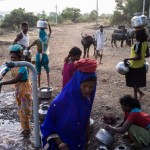Water Research, 11 June 2013
Comparing Microbial Water Quality in an Intermittent and Continuous Piped Water Supply
Emily Kumpel, et al.
Highlights
• Water quality was compared in an intermittent and continuous distribution system.
• Indicator bacteria were detected at higher concentrations in intermittent taps.
• A higher percentage of samples from continuous taps met free chlorine guidelines.
• There was evidence of intrusion in the intermittent distribution network.
• Drinking water stored in households with continuous supply became recontaminated.
Supplying piped water intermittently is a common practice throughout the world that increases the risk of microbial contamination through multiple mechanisms. Converting an intermittent supply to a continuous supply has the potential to improve the quality of water delivered to consumers. To understand the effects of this upgrade on water quality, we tested samples from reservoirs, consumer taps, and drinking water provided by households (e.g. from storage containers) from an intermittent and continuous supply in Hubli-Dharwad, India, over one year. Water samples were tested for total coliform, E. coli, turbidity, free chlorine, and combined chlorine. While water quality was similar at service reservoirs supplying the continuous and intermittent sections of the network, indicator bacteria were detected more frequently and at higher concentrations in samples from taps supplied intermittently compared to those supplied continuously (p<0.01).
Detection of E. coli was rare in continuous supply, with 0.7% of tap samples positive, compared to 31.7% of intermittent water supply tap samples positive for E. coli. In samples from both continuously and intermittently supplied taps, higher concentrations of total coliform were measured after rainfall events. While source water quality declined slightly during the rainy season, only tap water from intermittent supply had significantly more indicator bacteria throughout the rainy season compared to the dry season. Drinking water samples provided by households in both continuous and intermittent supplies had higher concentrations of indicator bacteria than samples collected directly from taps. Most households with continuous supply continued to store water for drinking, resulting in re-contamination, which may reduce the benefits to water quality of converting to continuous supply.




